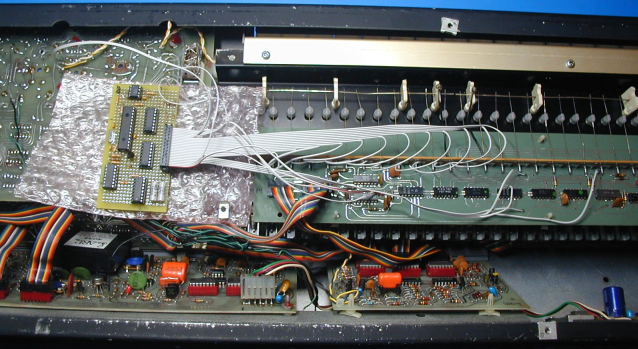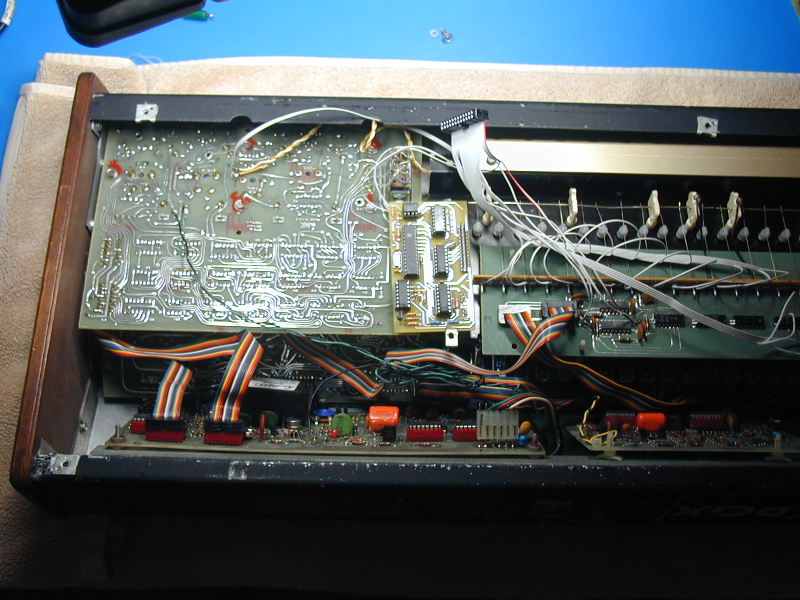A MIDI interface designed for the ARP PRO/Soloist/DGX Synthesizer (with extra keys!)

A friend recently asked if I could design a simple Note On/Off MIDI interface for the ARP PRO/DGX. He mentioned that the oscillator was controlled digitally by the keyboard, which sounded interesting, since this synth was designed before microprocessors were available. A brute force approach would involve some kind of MCU-controlled switch across each of the 37 keys, but the unusual key scan circuit actually made a much simpler design possible. I wanted to try implementing some kind of MIDI after-touch control as well, since it's a key feature of this synth. As the design progressed, I realized that the ARP circuit might support additional "virtual keys" above the physical keyboard of the synthesizer. On the first three units tested, I was able to add seven additional "keys" above the 37 of the ARP, for a total of 44 playable by MIDI. On the fourth unit, the top two MIDI keys (F# and G) did not work as expected, due to a limitation of the ARP circuitry. So on that unit, only 5 additional keys were added. (More on that later) The after-touch sensors on many older synths tend to lose sensitivity over time. For this reason, I decided to design based on the voltage range mentioned on the schematic, instead of copying the more limited range on the PRO/DGX that I was working with. I thought it might also be interesting to optionally use Note On velocity to control the amount of after-touch, as well as MIDI after-touch messages.
Here is a photo showing my prototype connected to a borrowed earlier revision PRO/DGX for initial testing:

And here is the pc board version in the same unit:

Here are the features of the final design:
44 "keys" playable by MIDI (7 extra "virtual" ones, above the ARP physical ones) (Note: Some units may not support all 7 extra keys, so YMMV)
Small pcb/low power design
No traces cut during installation.
Local keys can be played at the same time as MIDI notes, although only one note total at a time, of course.
Since the PRO/DGX and the Pro Soloist use the same keyboard and interface, the MIDI board can be used with either.
These settings can be changed by holding a single key at power-up, and are non-volatile:
MIDI channel (1-16)
Last MIDI note/low MIDI note priority selection (local keyboard is always low note priority)
Velocity controls after-touch (as well as MIDI after-touch messages) enable/disable
Here are the installation instructions for Pro Soloists and the first rev of the PRO/DGX.
Here are the installation instructions for the later version of the PRO/DGX with orange switches.
Here are the instructions for changing the settings.
Please note: This interface does not allow doing anything other than playing notes over MIDI and controlling the after-touch amount. It should only be installed by someone with an adequate understanding of electronics. If it is installed incorrectly, damage to the synthesizer circuitry could result. I will not be responsible for any damage to any instrument caused by either proper or improper use of the design presented here.
Assembled boards are $129.95 plus S&H, including mounting hardware and a piece of ribbon cable with the connector attached to one end. (Individual wires are not cut to length or stripped) Also includes parts list, schematic, and parts placement diagram. Please contact me if you are interested. Do not attempt installation unless you have good soldering skills. This is not a good project for learning how to solder.
Keep the keyboard ribbon cable as short as you can. I have not seen any problems, but did not try using a really long cable.